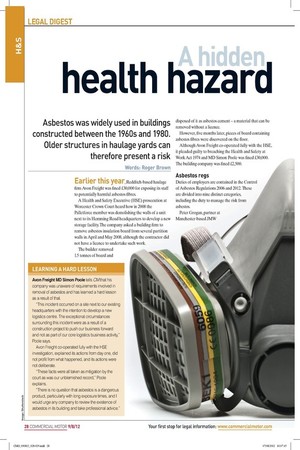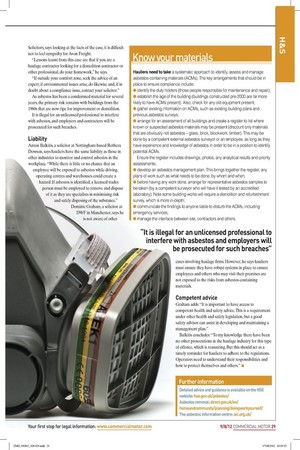A hidden
Page 19

Page 20

If you've noticed an error in this article please click here to report it so we can fix it.
health hazard
Asbestos was widely used in buildings constructed between the 1960s and 1980. Older structures in haulage yards can therefore present a risk
Words: Roger Brown Earlier this year, Redditch-based haulage irm Avon Freight was ined £30,000 for exposing its staff to potentially harmful asbestos ibres.
A Health and Safety Executive (HSE) prosecution at Worcester Crown Court heard how in 2008 the Palletforce member was demolishing the walls of a unit next to its Hemming Road headquarters to develop a new storage facility. The company asked a building irm to remove asbestos insulation board from several partition walls in April and May 2008, although the contractor did not have a licence to undertake such work.
The builder removed 1.5 tonnes of board and disposed of it as asbestos cement – a material that can be removed without a licence.
However, ive months later, pieces of board containing asbestos ibres were discovered on the loor.
Although Avon Freight co-operated fully with the HSE, it pleaded guilty to breaching the Health and Safety at Work Act 1974 and MD Simon Poole was ined £30,000. The building company was ined £2,500.
Asbestos regs
Duties of employers are contained in the Control of Asbestos Regulations 2006 and 2012. These are divided into nine distinct categories, including the duty to manage the risk from asbestos.
Peter Grogan, partner at Manchester-based JMW Solicitors, says looking at the facts of the case, it is dificult not to feel sympathy for Avon Freight.
“Lessons learnt from this case are that if you are a haulage contractor looking for a demolition contractor or other professional, do your homework,” he says.
“If outside your comfort zone, seek the advice of an expert; if environmental issues arise, do likewise and, if in doubt about a compliance issue, contact your solicitor.” As asbestos has been a condemned material for several years, the primary risk remains with buildings from the 1960s that are now ripe for improvement or demolition.
It is illegal for an unlicensed professional to interfere with asbestos, and employers and contractors will be prosecuted for such breaches.
Liability
Anton Balkitis, a solicitor at Nottingham-based Rothera Dowson, says hauliers have the same liability as those in other industries to monitor and control asbestos in the workplace. “While there is little or no chance that an employee will be exposed to asbestos while driving, operating centres and warehouses could create a hazard. If asbestos is identiied, a licensed trades person must be employed to remove and dispose of it as they are specialists in minimising risk and safely disposing of the substance.” Dominic Graham, a solicitor at DWF in Manchester, says he is not aware of other cases involving haulage irms. However, he says hauliers must ensure they have robust systems in place to ensure employees and others who may visit their premises are not exposed to the risks from asbestos-containing materials.
Competent advice
Graham adds: “It is important to have access to competent health and safety advice. This is a requirement under other health and safety legislation, but a good safety advisor can assist in developing and maintaining a management plan.”
Balkitis concludes: “To my knowledge there have been no other prosecutions in the haulage industry for this type of offence, which is reassuring. But this should act as a timely reminder for hauliers to adhere to the regulations. Operators need to understand their responsibilities and how to protect themselves and others.” ■
LEARNING A HARD LESSON
Avon Freight MD Simon Poole tells CM that his company was unaware of requirements involved in removal of asbestos and has learned a hard lesson as a result of that.
“This incident occurred on a site next to our existing headquarters with the intention to develop a new logistics centre. The exceptional circumstances surrounding this incident were as a result of a construction project to push our business forward and not as part of our core logistics business activity,” Poole says.
Avon Freight co-operated fully with the HSE investigation, explained its actions from day one, did not profit from what happened, and its actions were not deliberate.
“These facts were all taken as mitigation by the court as was our unblemished record,” Poole explains.
“There is no question that asbestos is a dangerous product, particularly with long exposure times, and I would urge any company to review the existence of asbestos in its building and take professional advice.”
Know your materials
Hauliers need to take a systematic approach to identify, assess and manage asbestos-containing materials (ACMs). The key arrangements that should be in place to ensure compliance include: • identify the duty holders (those people responsible for maintenance and repair); • establish the age of the building (buildings constructed pre-2000 are far more likely to have ACMs present). Also, check for any old equipment present; • gather existing information on ACMs, such as existing building plans and previous asbestos surveys; • arrange for an assessment of all buildings and create a register to list where known or suspected asbestos materials may be present (discount only materials that are obviously not asbestos – glass, brick, blockwork, timber). This may be done by a competent external asbestos surveyor or an employee, as long as they have experience and knowledge of asbestos in order to be in a position to identify potential ACMs.
Ensure the register includes drawings, photos, any analytical results and priority assessments; • develop an asbestos management plan. This brings together the register, any plans of work such as what needs to be done, by whom and when; • before having any work done, arrange for representative asbestos samples to be taken (by a competent surveyor who will have it tested by an accredited laboratory). Note some building works will require a demolition and refurbishment survey, which is more in-depth; • communicate the findings to anyone liable to disturb the ACMs, including emergency services; • manage the interface between site, contractors and others.
Further information
Detailed advice and guidance is available on the HSE website: hse.gov.uk/asbestos/
Asbestos removal: direct.gov.uk/en/ homeandcommunity/planning/doingworkyourself/ The asbestos information centre: aic.org.uk/









































